
1994 season
Main article: 1994 Toronto Blue Jays season
Expectations were high for the Blue Jays for the 1994 season, following back-to-back championships, but they slumped to a 55–60 record and a third place finish (16 games back of the New York Yankees) before the players' strike. It was their first losing season since 1982. Joe Carter, Paul Molitor and John Olerud enjoyed good years at the plate, but the pitching fell off. Juan Guzmán slumped considerably from his first three years (40–11, 3.28 ERA), finishing 1994 at 12–11 with a 5.68 ERA. Three young players, Alex Gonzalez, Carlos Delgado and Shawn Green, did show much promise for the future. At the time of the strike, their fellow Canadian cousins, the Montreal Expos had the best record in the majors, leading some to consider the possibility of a Canadian three-peat in 1994.
Labatt Breweries was bought by Belgian-based brewer Interbrew (which, in 2004, merged with AmBev to become InBev), making the Blue Jays the second baseball team owned by interests outside of North America, after the Blue Jays' expansion cousins, the Seattle Mariners.
• Team record 1994: 55 wins–60 losses, W%- 0.478, 16 games behind division leader
1995–2001: The Gord Ash era
1995–2000
On October 31, 1994, Pat Gillick, the longtime Blue Jays general manager, resigned and handed the reins of the team to Toronto native Gord Ash,[2] who would lead the team in its most tumultuous era yet.
In the 1995 season, the Blue Jays proved that they had lost their contending swagger of the past 12 years. Although they had most of the same cast of the World Series teams, the Blue Jays freefell to a dismal 56–88 record, last place in the AL East, 30 games behind the Boston Red Sox.
1996 was another mediocre year for the Blue Jays, despite Pat Hentgen's Cy Young Award (20–10, 3.22 ERA). Ed Sprague had a career year, hitting 36 home runs and driving in 101 runs. However, their 74 wins did put them in 4th place, improving over their last place finish in 1995.
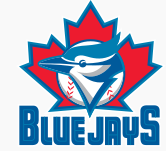
Toronto Blue Jays logo (1997–2002)
The Blue Jays started 1997 with high hopes. Not only did the Jays drastically change their uniforms, they signed former Boston Red Sox ace Roger Clemens to a $24,750,000 contract. Clemens had one of the best pitching seasons ever as he won the pitcher's Triple Crown, leading the American League with a record of 21–7, a 2.05 ERA, and 292 strikeouts. This was not enough to lead the Blue Jays to the postseason, however, as they finished in last place for the second time in three years with a record of 76–86. Cito Gaston, the longtime manager who led the team to four division titles and two World Series crowns, was fired five games before the end of the season. The season did provide a unique experience for its fans with the advent of Interleague play, when the Blue Jays faced their Canadian rival, the Montreal Expos, for the first official games between the two teams.
Before the start of the 1998 season, the Blue Jays acquired closer Randy Myers and slugger Jose Canseco. Gaston was replaced with former Blue Jay Tim Johnson, a relative unknown as a manager. Despite mediocre hitting, strong pitching led by Clemens' second straight pitching Triple Crown (20–6, 2.65 ERA, 271 strikeouts) sparked the Blue Jays to an 88–74 record – their first winning season since 1993. However, this was only good enough to finish a distant third, 26 games behind the New York Yankees, who posted one of the greatest records in all of baseball history at 114–48. They were, however, in contention for the wildcard spot until the final week.
Before the 1999 season, the Blue Jays traded Clemens to the Yankees for starting pitcher David Wells, second baseman Homer Bush and relief pitcher Graeme Lloyd. They also fired manager Tim Johnson during spring training after he lied about several things (including killing people in the Vietnam War) in order to motivate his players. The Blue Jays had initially been willing to stand by Johnson. A blizzard of questions about his credibility during spring training, however, led Ash to fire him less than a month before opening day. Johnson was replaced with Jim Fregosi, who managed the Phillies when they lost to the Blue Jays in the 1993 World Series. The offense picked up somewhat in 1999, but the pitching suffered without Clemens, as the Blue Jays finished at 84–78, in third place. After the 1999 season, the Blue Jays' original mascot for 20 years, BJ Birdy, was replaced by a duo namedAce and Diamond.
On November 8, 1999, Toronto traded star outfielder Shawn Green to the Los Angeles Dodgers for left-handed relief pitcher Pedro Borbón and right-fielder Raúl Mondesí. Green had told the Jays that he would not be re-signing when his contract was up at the end of the year (he wished to play closer to his home in Southern California).
2000 proved to be a similar season, as the Jays had an 83–79 record, well out of the wild card race but only a slim 4½ games back of the three-time defending World Series champion Yankees in the AL East, the first time since 1993 they had contended for the division. Carlos Delgado had a stellar year, hitting .344 with 41 home runs, 57 doubles, 137 RBI, 123 walks and 115 runs. In addition, six other players hit 20 or more home runs, an outstanding feat.
2000–01
On September 1, 2000, Rogers Communications Inc. purchased 80% of the baseball club with Interbrew (now[when?] InBev) maintaining 20% interest and the Canadian Imperial Bank of Commerce relinquishing its 10% share. Rogers eventually acquired the 20% owned by Interbrew and now has full ownership of the team.
Buck Martinez, a former catcher and broadcast announcer for the Blue Jays, took over as manager before the 2001 season. The Blue Jays were back under .500 for 2001, finishing at 80–82, with mediocre pitching and hitting. Delgado led the team again with 39 home runs and 102 RBI. After the 2001 season ended, the Blue Jays fired Gord Ash, ending a seven-year tenure as general manager.
J. P. Ricciardi, then director of player development under Oakland Athletics general manager Billy Beane, was named the Blue Jays' General Manager and was expected to slash the payroll immediately, in order to stem the tide of red ink. During the off-season, the team traded or let go several popular players, including Alex Gonzalez, Paul Quantrill, Brad Fullmer and closer Billy Koch to let talented youngsters such as Eric Hinske and Felipe Lopez get a chance to develop into major leaguers.
2002–09: The J. P. Ricciardi and Roy Halladay era
2002 season
Main article: 2002 Toronto Blue Jays season
The Blue Jays started the 2002 season with slow progress in performance. Buck Martinez was fired about a third of the way through the season, with a 20–33 record. He was replaced by third base coach Carlos Tosca, an experienced minor league manager. They went 58–51 under Tosca to finish the season 78–84. Roy Halladay was relied on as the team's ace and rose to the challenge of being the team's top pitcher, finishing the season with a 19–7 record and 2.93 ERA. The hitters were led once again by Carlos Delgado. Promising young players were assigned to key roles; starting third baseman Eric Hinske won the Rookie of the Year Award at the season's conclusion, and 23-year-old center fielder Vernon Wellshad his first 100 RBI season.
• Team record 2002: 78 wins–84 losses, W%- 0.481, 25.5 games behind division leader, third in division
2003 season
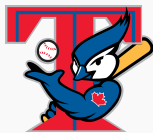
Toronto Blue Jays logo (2003)
Main article: 2003 Toronto Blue Jays season
The 2003 season was a surprise to both team management and baseball analysts. After a poor April, the team had its most successful month ever in May. Carlos Delgado led the majors in RBI, followed closely by Wells. Despite their hitting successes, poor pitching continued to plague the team. Halladay was an exception, winning his first Cy Young Award, going 22–7, with a 3.25 ERA. In July, Shannon Stewart was traded to theMinnesota Twins for Bobby Kielty, another outfielder with a much lower batting average than Stewart's. Although the Jays finished in third place in their division, Delgado was second in the voting for the American League MVP Award. In the off-season, Kielty was traded to the Oakland Athletics for starter Ted Lilly.
• Team record 2003: 86 wins–76 losses, W%- 0.531, 15 games behind division leader, third in division
2004 season

Toronto Blue Jays logo (2004–2011)
Main article: 2004 Toronto Blue Jays season
The 2004 season was a disappointing year for the Blue Jays right from the beginning. They started the season 0–8 at SkyDome and never started a lengthy winning streak. Much of that was due to injuries to All-Stars Carlos Delgado, Vernon Wells and Roy Halladay among others. Although the additions of starting pitchers Ted Lilly and Miguel Batista and reliever Justin Speier were relatively successful, veteran Pat Hentgen faltered throughout the season and retired on July 24. Rookies and minor league callups David Bush, Jason Frasor, Josh Towers and others filled the void in the rotation and the bullpen; however, inconsistent performances were evident. With the team struggling in last place and mired in a five-game losing streak, manager Carlos Tosca was fired on August 8, 2004, and was replaced by first base coach John Gibbons. Long-time first baseman Carlos Delgado became a free agent in the off-season. Nevertheless, prospects Russ Adams, Gabe Gross, and Alex Ríos provided excitement for the fans. Rookie pitchers David Bush, Gustavo Chacín and Jason Frasor also showed promise for the club's future. The Blue Jays' lone MLB All-Star Game representative was Lilly.
• Team record 2004: 67 wins–94 losses, W%- 0.416, 33.5 games behind division leader, fifth in division
2005 season
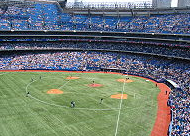
After the 2004 season, FieldTurf replaced AstroTurf as the Rogers Centre's playing surface.
Main article: 2005 Toronto Blue Jays season
The Blue Jays had a good start to the 2005 season. They led the AL East from early to mid-April and held their record around .500 until late August. The Jays were hit with the injury bug when third basemanCorey Koskie broke his finger, taking him out of the lineup, but the club was pleasantly surprised with the performance of rookie call-up Aaron Hill in his stead. On July 8, just prior to the All-Star break, Blue Jays ace Roy Halladay was struck on the shin by a line drive, resulting in a fractured leg. Though Halladay's injury was hoped to be minor, the recovery process was met with constant delays, and eventually, he was out for the rest of the season. Prior to his injury, the Blue Jays were in serious wild card contention, but soon fell out of the playoff race. The team received glimpses of the future from September call-ups Guillermo Quiróz, John-Ford Griffin, and Shaun Marcum. Marcum made himself noteworthy by posting an ERA of 0.00 over five relief appearances and eight innings in September. Josh Towers also stepped up, showing largely unseen potential by going 7–5 with a 2.91 ERA in the second half of the season.
• Team record 2005: 80 wins–82 losses, W%- 0.494, 15 games behind division leader, third in division
2006 season
Main article: 2006 Toronto Blue Jays season
In 2006, the team experienced its most successful season in years. On July 2, Troy Glaus, Vernon Wells, Roy Halladay, B. J. Ryan, and Alex Ríos were picked to represent the Blue Jays at the All-Star Game.[6]It was the largest number of Blue Jay All-Stars selected for the game since 1993. The team played well in the critical month of September, going 18–10. This, combined with the slumping of the Boston Red Sox, enabled the Blue Jays to take sole possession of second place in the American League East by the end of the season. This marked the first time that the Jays had finished above third place in their division since their World Championship season of 1993, and with the most wins since the 1998 season. On December 18, the Blue Jays announced that they had re-signed centre fielder Wells to a seven-year contract worth $126 million, which came into effect after the 2007 season.
• Team record 2006: 87 wins–75 losses, W%- 0.537, 10 games behind division leader, second in division
2007 season
Main article: 2007 Toronto Blue Jays season
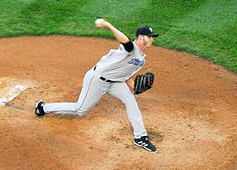
Dustin McGowan pitching for the Blue Jays in 2007
The 2007 season was blighted by persistent injuries, with 12 Blue Jays landing on the disabled list. The most serious injury was that of B. J. Ryan, who was out for the entire season having had Tommy John surgery. Prior to the season, the team signed starting pitchers John Thomson, Tomo Ohka, and Víctor Zambrano; each of them was released before the end of the season. However, young starters Shaun Marcum and Dustin McGowan had breakout years, with 12 wins each. On June 24, McGowan pitched a complete game one-hitter. On June 28, Frank Thomas became the 21st major league player to hit 500 career home runs. Aaron Hill also had a breakout year, setting a team record for second baseman with 47 doubles.
• Team record 2007: 83 wins–79 losses, W%- 0.512, 13 games behind division leader, third in division
2008 season
Main article: 2008 Toronto Blue Jays season
The Blue Jays' 2008 season featured a strong pitching staff, which led the major leagues with a 3.49 ERA. For much of the season, however, the team struggled to hit home runs and drive in runs. On May 24, starter Jesse Litsch set a team record, with 38 consecutive innings without giving up a walk. On June 20, following a five-game losing streak and with the Jays in last place in the AL East, management fired John Gibbons and several members of his coaching staff, and re-hired Cito Gaston. Meanwhile, Alex Ríos had 32 stolen bases, making him the first Blue Jay with 30 since 2001. On September 5, Roy Halladay earned his 129th career win, moving him into second spot on Toronto's all-time wins list. Halladay also came second in the voting for the Cy Young Award, after posting a 20–11 record and 2.78 ERA.
• Team record 2008: 86 wins–76 losses, W%- 0.531, 11 games behind division leader, fourth in division
2009 season
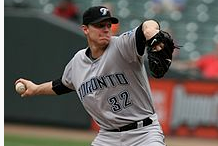
Blue Jays pitcher Roy Halladay
Main article: 2009 Toronto Blue Jays season
The 2009 season saw the addition of two new patches on the Blue Jays' uniforms: on the right arm, a bright red maple leaf (part of the Canadian flag), and on the left arm, a small black band with "TED" written on it, in reference to team owner Ted Rogers, who died in the off-season.
On opening day at the Rogers Centre, the Jays, led by Roy Halladay, beat the Detroit Tigers 12–5. Aaron Hill and Roy Halladay both had excellent years and represented the Blue Jays at the 2009 All-Star Game in St. Louis. Despite a hot start, the Jays quickly fell, including a nine-game losing streak, after starting with a 27–14 record. In mid-August, J. P. Ricciardi allowed the Chicago White Sox to claim Alex Ríos off waivers. With two games remaining in what was a disappointing season,Ricciardi was fired on October 3. He was replaced by assistant general manager Alex Anthopoulos.[7][8]
Despite a 75-win season, the Jays saw the strong return of Aaron Hill, who won the American League Comeback Player of the Year Award and the Silver Slugger for second base. Adam Lind, who also had a strong season, earned the Silver Slugger for designated hitter.
• Team record 2009: 75 wins–87 losses, W%- 0.463, 28 games behind division leader, fourth in division
2010–present: The Alex Anthopoulos and José Bautista era
2010 season
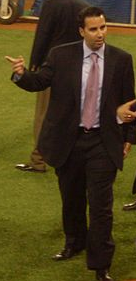
2010 was Alex Anthopoulos' first full season as General Manager of the Jays.
Main article: 2010 Toronto Blue Jays season
In the off-season, the Jays' ace Roy Halladay was traded to the Philadelphia Phillies for Kyle Drabek, Travis d'Arnaud, and Michael Taylor; Taylor was immediately traded to the Oakland Athletics for Brett Wallace. The team's significant free agent signings were that of catcher John Buck and shortstop Álex González.[9]



















